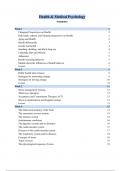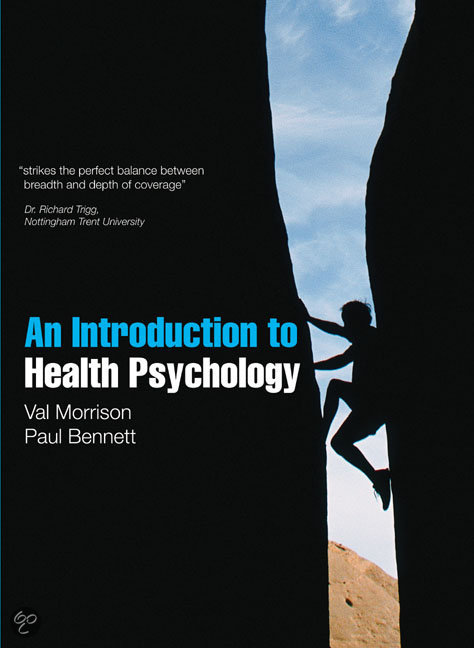Health & Medical Psychology
Summary
Week 1 2
Changing Perspectives on Health 2
Individual, cultural, and lifespan perspectives on Health 2
Aging and Health 2
Health differentials 3
Gender and health 4
Smoking, drinking, and illicit drug use 4
Unhealthy Diet and Obesity 5
Adherence 5
Health screening behavior 5
Models about the influences of health behavior 6
Lecture 7
Week 2 9
Public health interventions 9
Strategies for motivating change 9
Strategies for driving change 10
Lecture 10
Week 3 12
Stress management training 12
Third wave therapies 12
Acceptance and Commitment Therapy (ACT) 13
Stress in organizations and hospital settings 13
Lecture 13
Week 4 15
The behavioral anatomy of the brain 15
The autonomic nervous system 15
The immune system 15
Autoimmune conditions 16
The digestive system and its disorders 16
The cardiovascular system 17
Diseases of the cardiovascular system 17
The respiratory system and its diseases 18
Concepts of stress 18
Types of stress 19
The physiological response of stress 19
, Stress, coping, and personality 20
Social support and stress 21
Lecture 21
Week 5 22
Symptom perception 22
Responding to symptoms 23
The medical consultation 23
Bad news consultation 23
Beyond the consultation 24
Lecture 24
Week 6 26
The challenges and impact of illness 26
Emotional reactions to illness 26
Coping with illness 27
Quality of Life 27
Informal care 28
Family and Caregiving 28
Lecture 29
Week 7 29
Experience of Pain 30
Models of pain 30
Helping people cope with pain 31
Lecture 32
Week 8 34
Coping with chronic illness 35
Lecture 35
1
, Week 1
Chapters 1, (2), 3, 4, and 5
Changing Perspectives on Health
Health is a word that has held many different meanings throughout different times,
cultures, or ages. A few historical theories highlight this;
● Hippocrates attributed illness to the balance between four circulating fluids. These fluids,
called humor, were attached to seasonal variations. This is the humoral theory of
illness.
● Galen added to the latter theory that temperament could contribute to the occurrence of
specific illnesses.
● During the middle ages, health was seen as God’s punishment for misdeeds.
● After the Renaissance, the scientific revolution helped in gaining more understanding
about the body and the workings of illnesses.
● The biomedical model of illness defines health as the absence of disease. It views the
body as working rather mechanically. This stems from dualistic thinking.
Individual, cultural, and lifespan perspectives on Health
The WHO defines health as a “state of complete physical, mental, and social
well-being”. Multiple surveys have been conducted to understand how people may perceive
health. In these, feeling, symptom orientation, and performance, are recurrent responses.
However, responses varied a lot, showing that the way we perceive health is often multifaceted.
Westerners have the tendency to divide the mind, body, and soul a lot in terms of medical care.
However, in many other non-western cultures, there is a more holistic view of the workings of
the body. Furthermore, in some African regions, there is a more collectivist approach to staying
healthy than in European countries.
Aging and Health
The developmental process of aging is a combination of learning, experience, and
maturation. It is also important to consider multiple different dimensions such as cognitive and
intellectual functioning or communication skills. These can impact the person’s tendency to
express distress or seek help. According to Piaget’s theory, different stages throughout childhood
reflect a growing understanding of illness. These can be seen here below.
Sensorimotor (0-2 years) -
Preoperational (2-7 years) Children in that stage typically still use
2
, magical explanations for illness, based on
incomprehension and phenomenonism
Concrete operational (7-11 years) Illness is understood as more concrete and
based on a causal sequence. The concept of
contamination and internalization is grasped.
It is around 11 that children distinguish mind
and body
Formal operational (12+) Illness is understood on an abstract level.
There is a physiological and
psychophysiological understanding of illness
is understood.
After adolescence, adulthood is associated with less risky behavior. Transitions into
adulthood have different effects on different populations; men seem to fare better married
whereas women do not show the same consequence. Self-concept has been shown to be
relatively stable throughout aging.
Health differentials
There are big differences of life expectancies both between countries and within
countries. It has actually been shown that even modest differences in wealth can influence health
throughout society. There are a few explanations for that phenomenon:
● The social drift hypothesis. This hypothesis suggests that when an individual develops a
health problem, they have more difficulties maintaining their standard of living and
therefore drift to a lower SE’s class
● Different health behaviors. People in low SE’s engage in more risky or unhealthy
behaviors such as smoking or drinking
● Access to health care
● Environmental factors
● The stress hypothesis. People in lower SES groups experience more stress than their
affluent counterparts (housing, threat of unemployment, etc). This can lead to an adverse
impact on health. It has been found that subjective SES was a better predictor of
health than objective SES.
Three key factors have been shown to influence or contribute to work stress: the demands
of the job, the autonomy, and the degree of available social support.
3





